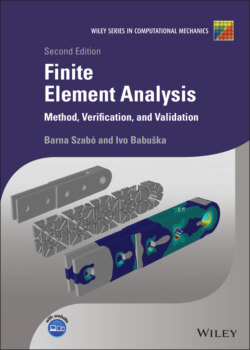Читать книгу Finite Element Analysis - Barna Szabó - Страница 42
1.5.2 A priori estimation of the rate of convergence
ОглавлениеAnalysts are called upon to choose discretization schemes for particular problems. A sound choice of discretization is based on a priori information on the regularity of the exact solution. If we know that the exact solution lies in Sobolev space then it is possible to say how fast the error in energy norm will approach zero as the number of degrees of freedom is increased, given a scheme by which a sequence of discretizations is generated. Index k can be inferred or estimated from the input data κ, c and f.
We define
(1.90)
where ℓj is the length of the jth element, is the size of the of the solution domain . This is generalized to two and three dimensions where is the diameter of the domain and ℓj is the diameter of the jth element. In this context diameter means the diameter of the smallest circlein one and two dimensions, or sphere in three dimensions,that contains the element or domain. In two and three dimensions the solution domain is denoted by Ω.
The a priori estimate of the relative error in energy norm for , quasiuniform meshes and polynomial degree p is
(1.91)
where is the energy norm, k is typically a fractional number and is a positive constant that depends on k but not on h or p. This inequality gives the upper bound for the asymptotic rate of convergence of the relative error in energy norm as or [22]. This estimate holds for one, two and three dimensions. For one and two dimensions lower bounds were proven in [13, 24] and [46] and it was shown that when singularities are located in vertex points then the rate of convergence of the p‐version is twice the rate of convergence of the h‐version when both are expressed in terms of the number of degrees of freedom. It is reasonable to assume that analogous results can be proven for three dimensions; however, no proofs are available at present.
We will find it convenient to write the relative error in energy norm in the following form
(1.92)
where N is the number of degrees of freedom and C and β are positive constants, β is called the algebraic rate of convergence. In one dimension for the h‐version and for the p‐version. Therefore for we have . However, for the important special case when the solution has the functional form of eq. (1.89) or, more generally, has a term like and is a nodal point then for the p‐version: The rate of p‐convergence is twice that of h‐convergence [22, 84].
When the exact solution is an analytic function then and the asymptotic rate of convergence is exponential:
(1.93)
where C, γ and θ are positive constants, independent of N. In one dimension , in two dimensions , in three dimensions , see [10].
When the exact solution is a piecewise analytic function then eq. (1.93) still holds provided that the boundary points of analytic functions are nodal points, or more generally, lie on the boundaries of finite elements.
The relationship between the error measured in energy norm and the error in potential energy is established by the following theorem.
Theorem 1.5
(1.94)
Proof: Writing and noting that , from the definition of we have:
Remark 1.10 Consider the problem given by eq. (1.5) and assume that κ and c are constants. In this case the smoothness of u depends only on the smoothness of f: If then for any . Similarly, if then for any . This is known as the shift theorem. More generally, the smoothness of u depends on the smoothness of κ, c and F. For a precise statement and proof of the shift theorem we refer to [21].
Remark 1.11 An introductory discussion on how a priori estimates are obtained under the assumption that the second derivative of the exact solution is bounded can be found in Appendix B.
